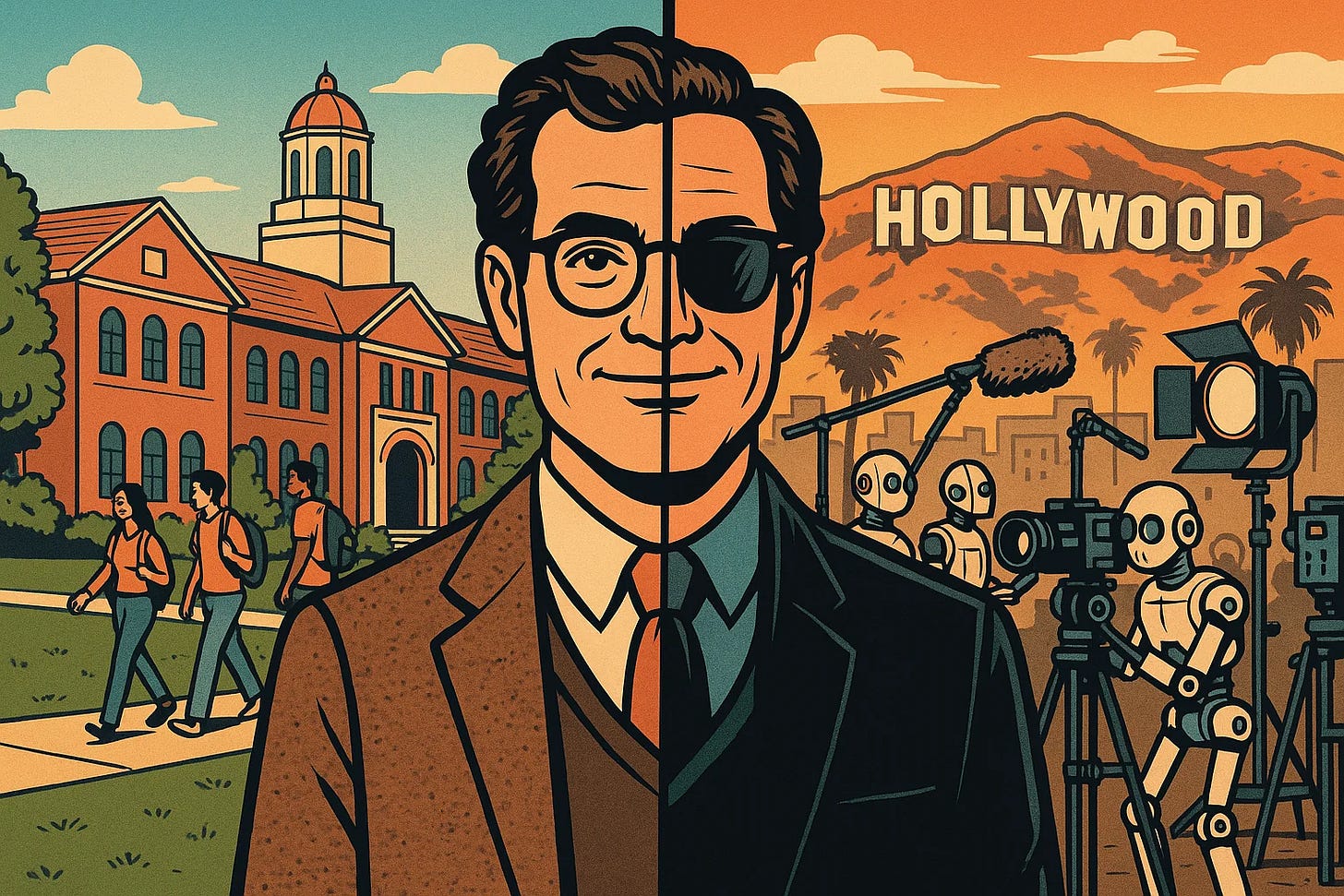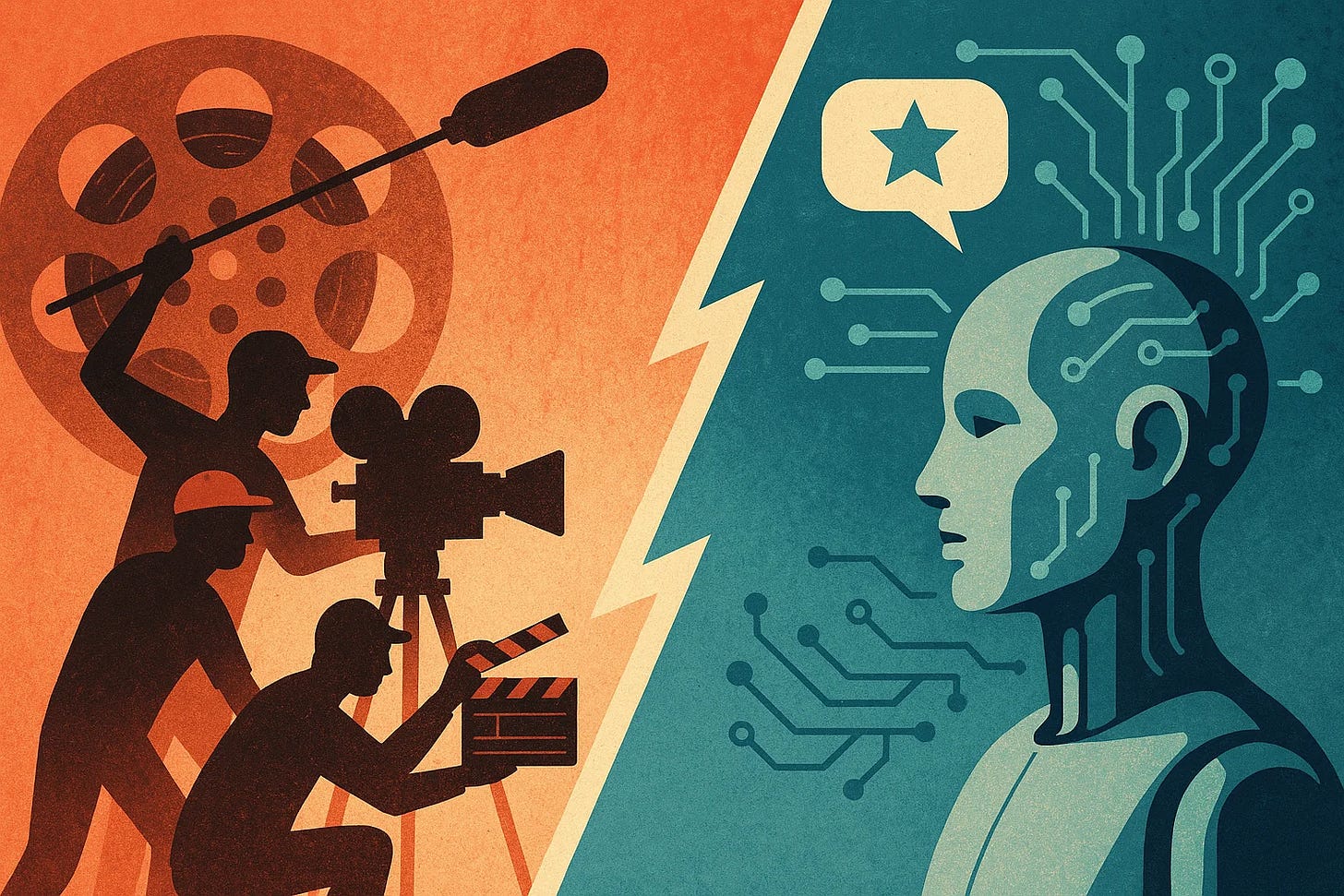PODCAST/ ESSAY: The Professor and the Producer
Machine Cinema speaks to USC's Stephen Gibler
Links to longer conversation on Youtube, Spotify, and Apple. Follow us on Instagram.
Stephen Gibler lives a professional double life. As a USC film professor, he walks into classrooms where students increasingly view AI with suspicion and fear. Hours later, as an AI-focused producer for clients like Walmart, Google, and Microsoft, he leverages the very technology his students resist to build a thriving creative career. Few people inhabit both sides of the AI divide in creative industries as completely as Gibler, making his perspective uniquely valuable in understanding the fundamental tension reshaping the world of film and media production.
The Producer's View: Breaking Down Barriers
When speaking as a producer, Gibler's enthusiasm for AI is unrestrained. "AI has a chance to drop these budgets down so much that the risk is removed and therefore, we could tell the real shit without the gatekeepers," he explains with characteristic directness. To him, this is revolutionary—not about replacing human creativity but demolishing the financial walls that have kept so many voices silent.
"Our industry is built by people with access," Gibler asserts. "Access comes from wealth... The family you were born into, the zip code you were born in." From this perspective, AI represents liberation from a system that has privileged the already-privileged, allowing creators without financial resources to produce work that "looks big, amazing and cool."
This isn't abstract theory for Gibler—it's lived experience. After two years without steady work, despite an established producing career, he found his way back through AI. "For people who are interested in the AI stuff, hard press yourself into this. This is like the thing that gives you allowance to get into doors where others could not." His career revival through AI expertise fuels his belief in its transformative potential.
From Novelty to Profession
What makes this moment particularly significant is that AI in creative fields is transitioning from novelty to specialization. We're witnessing what Gibler describes as "this kind of emerging creative industry" where roles are becoming more defined and professional pathways more established.
This evolution brings legitimacy but also competition. While Gibler encourages newcomers—"The best time to plant a tree was 20 years ago. The second best time is now"—he acknowledges that those entering the AI creative community today are "a little behind." The early adopters have built trust and intuition about where the technology is heading.
Yet opportunities remain abundant. As AI capabilities continue to expand, Gibler sees untapped potential in areas like AI-driven animation: "How many AI animated features have there been? Zero. But like in two years, we're gonna be like, wow, some really good stuff got made."
The Professor's Dilemma: Watching the Mood Shift
It's in his role as professor that Gibler witnesses the opposing forces of resistance and anxiety. His classroom became an inadvertent observatory for the industry's shifting relationship with AI.
"In January 2023, I'm like, I think in every one of my classes, I brought it up," he recalls. Initially, students were "open and interested," mirroring his own excitement about creative possibilities.
Then came the Hollywood strikes.
"You can see in real time the anti-AI sentiment really cranked," he observes. "From end of April to by early June, like a sea change." This transformation was physical, even affecting how people carried themselves when discussing AI. Where once there was curiosity, now he faced resistance, often hostility.
The shift placed Gibler in an increasingly uncomfortable position. The technology fueling his professional renaissance was becoming taboo in his teaching environment. By late 2023, he noticed students "started to kind of secretly reopen to it," using AI tools without explicitly naming them. The professor who once enthusiastically introduced students to AI tools now finds himself cautious: "I'm probably not going to like talk to my students really about AI much after seeing really firsthand a week and a half ago how they responded."
Standing Astride the Divide
The stark contrast between Gibler's flourishing AI-powered career and his increasingly AI-resistant classroom exemplifies the fundamental divide in creative industries today. In one world, AI represents liberation from gatekeepers; in the other, it's perceived as an existential threat.
"I view sometimes the anti-AI sentiment as behind something else," Gibler observes. "If jobs were robust in the film industry, nobody would give a shit." This insight—that resistance often stems from economic insecurity rather than creative principles—comes from someone who has seen both sides up close.
Film schools like USC now stand at a precarious crossroads. These institutions are built on traditions, techniques, and philosophies carefully passed through generations. Yet they must now reckon with technologies that fundamentally challenge those traditions. The recent panel where Gibler witnessed strong pushback revealed how deep this conflict runs.
"I care for them," he says of his students, "but I think we need some time as a society to figure this thing out." The emotional honesty of this statement reveals someone trying to reconcile his enthusiasm for AI's creative possibilities with his genuine concern for students facing an uncertain industry.
"There's a pace of disruption now that threatens that comfort" of traditional educational institutions, Gibler notes. The future may belong less to established programs and more to "something a lot more nimble and fluid and self-guided." Yet as someone invested in both the tradition and the disruption, his perspective contains both excitement and melancholy.
Navigating the Divide
Gibler's advice stems from his unique position at the intersection of tradition and innovation. For aspiring creators, he emphasizes action over hesitation: "Clear out time and make stuff. This is one of those times you look back and you're like, damn, I wish I made a bunch more stuff."
He offers practical paths forward: "If you want to call yourself a producer, just help manage people, do stuff they don't want to do for AI creators." This democratization of roles mirrors the democratization of tools that AI enables.
Yet the professor in him remains attuned to the human cost of disruption. After witnessing strong student reaction to AI discussions, he acknowledges, "I was like, shoot, maybe I need to firm up some of these arguments that I got going on"—a humble recognition that even advocates must continually refine their positions.
"Are we being constructive in this thing?" Gibler asks. "This AI thing, it's just another part of a human puzzle that just seems to, instead of coming together, these puzzle pieces are spreading apart."
In Gibler's divided professional life, we see a microcosm of the larger forces reshaping creative industries. The professor mindful of tradition and the producer embracing disruption exist in the same person—just as the promise of democratization and the threat to established pathways exist in the same technology.
The creative world must learn to inhabit both sides of this divide—embracing new possibilities while respecting the human concerns that accompany them. The future belongs to those who can remain "constructive in this thing" we're all building together.
To learn more about Stephen and his work follow him on Linkedin.
Words by humans + Claude. Images by Sora and Canva.






